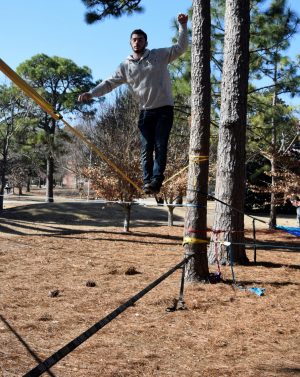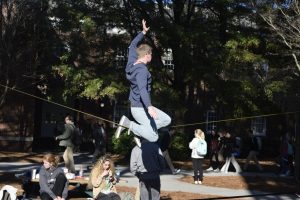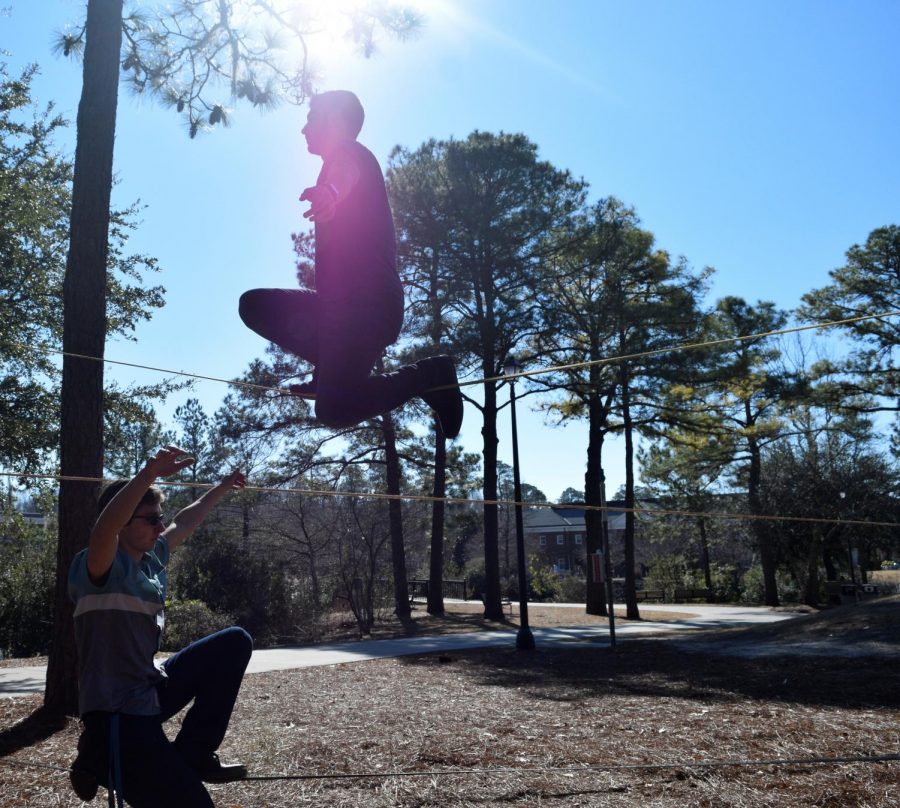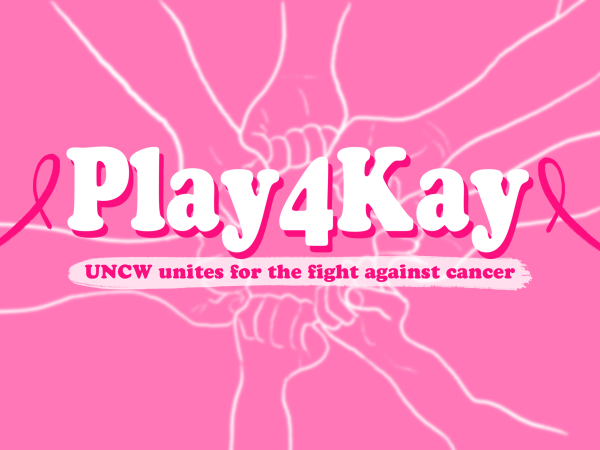Slack(lin)ing off: UNCW students showcase slacklining in campus commons
If you’ve ever wandered near the clocktower by Randall Library on a sunny day, you may have noticed a group of people taking turns toeing

across what could be described as a wobbly tightrope, suspended just a few feet above the pine needle-covered ground. As it turns out, that wobbly tightrope is called a slackline, and what was once a rest-day activity for avid rock climbers is now a burgeoning sport in itself in the UNC Wilmington community and elsewhere.
Slacklining involves walking, balancing, and doing tricks on a length of flat webbing, tethered between two anchors. Unlike walking on a tightrope, the line you work with while slacklining is wider – usually two inches – and has a bit of bounce to it. It gives in to your movements and weight to an extent, hence the “slack.”
For some, slacklining is a serious sport; for others, it is more of a hobby or social event. Like most other sports and hobbies, getting good at slacklining takes some time and effort, but not so much that you can’t do it casually. Your skill level correlates to the amount of effort you put into learning and practicing. While there are elite, competitive slackliners out there who push the activity to the extreme, a high degree of intensity is not necessary for slacklining to be enjoyable.
“I think it is similar to surfing – depending on who you ask, it could be considered a hobby, sport, passion, or religion,” says UNCW student Josh Kraft. “But it doesn’t require much athleticism to have fun. For me, slacklining is just another interesting way to spend time outdoors.”
In any case, slacklining does necessitate at least some core strength and an ability to stay upright on unsteady terrain. Part of the process of becoming a decent slackliner is learning “dynamic balance,” which involves being able to stabilize yourself on an unstable surface.
“Slacklining is kind of like learning to ride a bike with a little more of a learning curve,” says UNCW student Bryson Harllee. “But anyone can get good at it; they just have to get the muscles in their feet, ankles, and legs used to the feeling.”
Harllee got into slacklining around 2012 when he saw some classmates setting up the line behind Deloach Hall on campus. He asked them what they were doing, tried it for himself and then, he says, he was hooked.

“I spent hours that day trying to figure out how to balance,” he says. “Usually if someone tries it every day for an hour a day, after a couple weeks they’re walking around on it trying to do tricks and other fun stuff.”
Today, Harllee is a common face in the crowd by the clocktower on any given day and he is always willing to lend a hand to curious newcomers. The slacklining community at UNCW – officially a student organization and appropriately coined @uncw_slackers on Instagram – is carefree and casual, always open to making new friends.
“Anyone can try it if they want, and we don’t mind people walking up and asking questions,” says Harllee. “We are always willing to lend a hand to help balance because it feels weird and new the first time you get on, [and] we’ll even provide someone on each side to help you balance if you’re really nervous.”
UNCW’s slacklining community isn’t limited to just slackliners; you might also encounter people who enjoy hammocking, acoustic instruments, climbing, hula hooping and even fire-breathing.
“Really, we meet a wide variety of people from people in the air force to the craziest hippies out there and we all enjoy each other’s company,” says Harllee.
For those interested in getting into slacklining on their own, it isn’t challenging to get started.
Some of Harllee’s advice for newcomers is to begin with the line as low to the ground as you like; apply all your weight onto the line at once and step right up; try not to look at your feet, but focus on something ahead instead; and don’t be afraid to use your arms and hips to adjust your balance as necessary.

“Many slackliners look like swaying trees or weird monks because we all make those tiny adjustments to our balance in different ways,” says Harllee.
As far as the cost of equipment goes, “you can definitely get into slacklining for under $100,” says Kraft. The necessities are a line and two anchor ratchets, and beginner’s kits with these pieces are available online.
Of course, like most other hobbies, you get what you pay for, and as you get better, so does your equipment, Harllee points out. Your investment will grow with your interest.
And as far as finding a good place to set up, Wilmington and the surrounding areas have a wealth of places to hang out and practice, from on-campus spots to local parks, to beneath the piers at Wrightsville beach.
“We have plenty of pine needles and sand here in Wilmington, which usually makes for soft landings,” Kraft says.
All in all, slacklining is a mellow way to spend some time outdoors and have some fun. Whether you choose to check out the slackliners hanging out by the clocktower or just dive in solo, if you start low and take it easy, soon you’ll be slacking off with the best of them.







